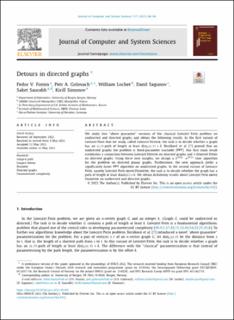| dc.contributor.author | Fomin, Fedor | |
| dc.contributor.author | Golovach, Petr | |
| dc.contributor.author | Lochet, William Alexandre | |
| dc.contributor.author | Sagunov, Danil | |
| dc.contributor.author | Saurabh, Saket | |
| dc.contributor.author | Simonov, Kirill | |
| dc.date.accessioned | 2024-04-17T11:23:48Z | |
| dc.date.available | 2024-04-17T11:23:48Z | |
| dc.date.created | 2023-06-15T17:32:31Z | |
| dc.date.issued | 2023 | |
| dc.identifier.issn | 0022-0000 | |
| dc.identifier.uri | https://hdl.handle.net/11250/3127012 | |
| dc.description.abstract | We study two “above guarantee” versions of the classical Longest Path problem on undirected and directed graphs and obtain the following results. In the first variant of Longest Path that we study, called Longest Detour, the task is to decide whether a graph has an (s, t)-path of length at least distG (s, t) + k. Bezáková et al. [7] proved that on undirected graphs the problem is fixed-parameter tractable (FPT). Our first main result establishes a connection between Longest Detour on directed graphs and 3-Disjoint Paths on directed graphs. Using these new insights, we design a 2O(k) · nO(1) time algorithm for the problem on directed planar graphs. Furthermore, the new approach yields a significantly faster FPT algorithm on undirected graphs. In the second variant of Longest Path, namely Longest Path above Diameter, the task is to decide whether the graph has a path of length at least diam(G) + k. We obtain dichotomy results about Longest Path above Diameter on undirected and directed graphs. | en_US |
| dc.language.iso | eng | en_US |
| dc.publisher | Elsevier | en_US |
| dc.rights | Navngivelse 4.0 Internasjonal | * |
| dc.rights.uri | http://creativecommons.org/licenses/by/4.0/deed.no | * |
| dc.title | Detours in directed graphs | en_US |
| dc.type | Journal article | en_US |
| dc.type | Peer reviewed | en_US |
| dc.description.version | publishedVersion | en_US |
| dc.rights.holder | Copyright 2023 The Author(s) | en_US |
| cristin.ispublished | true | |
| cristin.fulltext | original | |
| cristin.qualitycode | 1 | |
| dc.identifier.doi | 10.1016/j.jcss.2023.05.001 | |
| dc.identifier.cristin | 2155035 | |
| dc.source.journal | Journal of computer and system sciences | en_US |
| dc.source.pagenumber | 66-86 | en_US |
| dc.relation.project | Norges forskningsråd: 314528 | en_US |
| dc.identifier.citation | Journal of computer and system sciences. 2023, 137, 66-86. | en_US |
| dc.source.volume | 137 | en_US |

